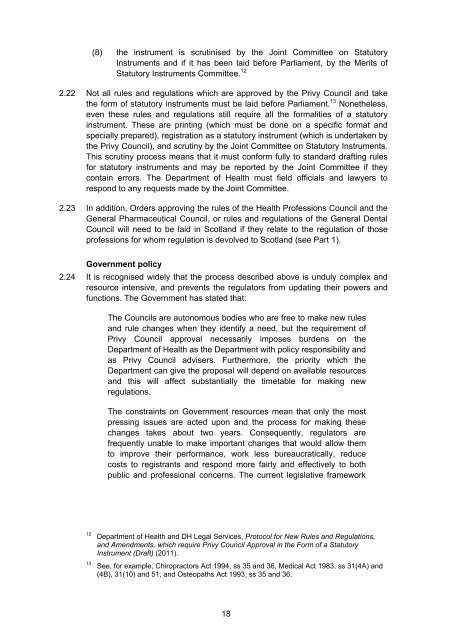Regulation of Health and Social Care Professionals Consultation
Regulation of Health and Social Care Professionals Consultation
Regulation of Health and Social Care Professionals Consultation
Create successful ePaper yourself
Turn your PDF publications into a flip-book with our unique Google optimized e-Paper software.
(8) the instrument is scrutinised by the Joint Committee on Statutory<br />
Instruments <strong>and</strong> if it has been laid before Parliament, by the Merits <strong>of</strong><br />
Statutory Instruments Committee. 12<br />
2.22 Not all rules <strong>and</strong> regulations which are approved by the Privy Council <strong>and</strong> take<br />
the form <strong>of</strong> statutory instruments must be laid before Parliament. 13 Nonetheless,<br />
even these rules <strong>and</strong> regulations still require all the formalities <strong>of</strong> a statutory<br />
instrument. These are printing (which must be done on a specific format <strong>and</strong><br />
specially prepared), registration as a statutory instrument (which is undertaken by<br />
the Privy Council), <strong>and</strong> scrutiny by the Joint Committee on Statutory Instruments.<br />
This scrutiny process means that it must conform fully to st<strong>and</strong>ard drafting rules<br />
for statutory instruments <strong>and</strong> may be reported by the Joint Committee if they<br />
contain errors. The Department <strong>of</strong> <strong>Health</strong> must field <strong>of</strong>ficials <strong>and</strong> lawyers to<br />
respond to any requests made by the Joint Committee.<br />
2.23 In addition, Orders approving the rules <strong>of</strong> the <strong>Health</strong> Pr<strong>of</strong>essions Council <strong>and</strong> the<br />
General Pharmaceutical Council, or rules <strong>and</strong> regulations <strong>of</strong> the General Dental<br />
Council will need to be laid in Scotl<strong>and</strong> if they relate to the regulation <strong>of</strong> those<br />
pr<strong>of</strong>essions for whom regulation is devolved to Scotl<strong>and</strong> (see Part 1).<br />
Government policy<br />
2.24 It is recognised widely that the process described above is unduly complex <strong>and</strong><br />
resource intensive, <strong>and</strong> prevents the regulators from updating their powers <strong>and</strong><br />
functions. The Government has stated that:<br />
The Councils are autonomous bodies who are free to make new rules<br />
<strong>and</strong> rule changes when they identify a need, but the requirement <strong>of</strong><br />
Privy Council approval necessarily imposes burdens on the<br />
Department <strong>of</strong> <strong>Health</strong> as the Department with policy responsibility <strong>and</strong><br />
as Privy Council advisers. Furthermore, the priority which the<br />
Department can give the proposal will depend on available resources<br />
<strong>and</strong> this will affect substantially the timetable for making new<br />
regulations.<br />
The constraints on Government resources mean that only the most<br />
pressing issues are acted upon <strong>and</strong> the process for making these<br />
changes takes about two years. Consequently, regulators are<br />
frequently unable to make important changes that would allow them<br />
to improve their performance, work less bureaucratically, reduce<br />
costs to registrants <strong>and</strong> respond more fairly <strong>and</strong> effectively to both<br />
public <strong>and</strong> pr<strong>of</strong>essional concerns. The current legislative framework<br />
12 Department <strong>of</strong> <strong>Health</strong> <strong>and</strong> DH Legal Services, Protocol for New Rules <strong>and</strong> <strong>Regulation</strong>s,<br />
<strong>and</strong> Amendments, which require Privy Council Approval in the Form <strong>of</strong> a Statutory<br />
Instrument (Draft) (2011).<br />
13 See, for example, Chiropractors Act 1994, ss 35 <strong>and</strong> 36, Medical Act 1983, ss 31(4A) <strong>and</strong><br />
(4B), 31(10) <strong>and</strong> 51, <strong>and</strong> Osteopaths Act 1993, ss 35 <strong>and</strong> 36.<br />
18
















